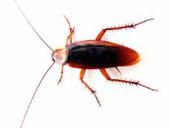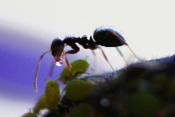We are Here to Educate and Eradicate
Call Us TODAY!
Our Pest management techniques are strictly enforced and follow all national/state guidelines. Our technicians go through an extensive training schedule including classroom work and field
experience. Our technicians are state certified and hold higher degrees of education including PhD and MS.
We utilize an Integrated Pest Management program which includes the following steps:
1. Inspection
2. Determination of Pest Thresholds
3. Application of Pest Management Procedures
4. Evaluation: monitoring of pest populations and the management program, and repeating measures as needed.
Following these steps, pesticide applications are kept to a minimum and, when used, have a minimal impact on the environment. We use only the highest quality products and equipment to provide the
best service possible.
Our pest management covers a wide variety of insects and includes: Cockroaches, House Ants, Silverfish, Spiders, Wasps/Yellow
Jackets and Mice. We also provide service for other insect pest problems including Bed Bugs, Mosquitoes, Fleas,
Ticks, Occasional Pest, and Others. Our service includes an interior service and outside perimeter service. We also back our pest control services with a NO CHARGE call back treatment Guarantee.
Cockroaches are generally either scavengers or omnivores. Cockroaches are most common in tropical and subtropical climates. Some species are in close association with human dwellings and widely found around garbage or in the kitchen. Cockroaches live in a wide range of environments around the world. Pest species of cockroaches adapt readily to a variety of environments, but prefer warm conditions such as found within buildings. Many tropical species prefer even warmer environments and do not fare well in the average household. Only a small handful of the 3,500 or so species of cockroach are suited to thrive in the typical home. Female cockroaches are sometimes seen carrying egg cases on the end of their abdomen; the egg case of the German cockroach holds about 30–40 long, thin eggs, packed like frankfurters in the case called an ootheca. A female German cockroach carries an egg capsule containing around 40 eggs. She drops the capsule prior to hatching. Development from eggs to adults takes 3-4 months. Cockroaches live up to a year. The female may produce up to eight egg cases in a lifetime; in favorable conditions, it can produce 300-400 offspring. Cockroaches are mainly nocturnal and will run away when exposed to light. A peculiar exception is the Oriental cockroach, which is attracted to light, thus making it a far more annoying pest. The cockroach is also one of the hardiest insects on the planet, capable of living for a month without food. It can also hold its breath for 45 minutes and has the ability to slow down its heart rate.
A 2005 US national study on factors that affect asthma in inner-city children shows that cockroach allergens appear to worsen asthma symptoms more than other known triggers. This study, funded by the US National Institute of Environmental Health Sciences (NIEHS) and the US National Institute of Allergy and Infectious Diseases (NIAID), is the first large-scale study to rank asthma triggers according to severity. Additionally, a 2005 research study, sponsored by the National Pest Management Association (NPMA), shows a disparity in homeowner knowledge about this link. Only 10% of homeowners nationwide feel that cockroaches are a threat to their family’s health.
Ants are social insects that belong to the same order as the wasps and bees. They are of particular interest because of their highly organized colonies or nests which sometimes consist of millions of individuals. Individuals are divided into infertile female workers and fertile males (drones) and females (queens). Ants are distinguished from other insects by the following traits: elbowed antennae; a strongly constricted second abdominal segment forming a distinct node-like petiole; the petiole can be formed by one or two "parts" or segments (only the second, or the second and third abdominal segments can form it).
Typical ants that are classified as pests include Pavement Ants (otherwise known as the sugar ant), Pharaoh Ants, and Argentine Ants. Control of species populations are usually done with bait insecticides, which are either in the form of small granules, or as a sticky liquid that is gathered by the ants as food and then brought back to the nest where the poison is inadvertently spread to other members of the brood — a system that can severely reduce the numbers in a colony if used properly.
Lepisma saccharina (commonly called the fishmoth, urban silverfish or just the silverfish) is a small, wingless insect typically measuring between half to one inch. Its common name derives from the animal's silvery grey colour, combined with the fish-like appearance of its movements, while the scientific name indicates the silverfish's diet of carbohydrates such as sugar or starches. It belongs to the basal insect order Thysanura, and the species is estimated to have existed for 300 million years. The favorite food of silverfish is any matter that contains starch or polysaccharides, such as dextrin in adhesives. These include glue, book bindings, paper, photos, sugar, hair, dandruff, and dirt. Silverfish can also cause damage to books, tapestries, and textiles. Apart from these cases, the damage caused by silverfish is negligible, and they have no direct effect on human health beyond psychological distress to people who dislike them. Other substances that may be eaten include cotton, linen, silk and synthetic fibres, and dead insects or even its own exuvia (moulted exoskeleton). During famine, a silverfish may even attack leatherware and synthetic fabrics. In extreme cases, silverfish may live for several months without feeding.




